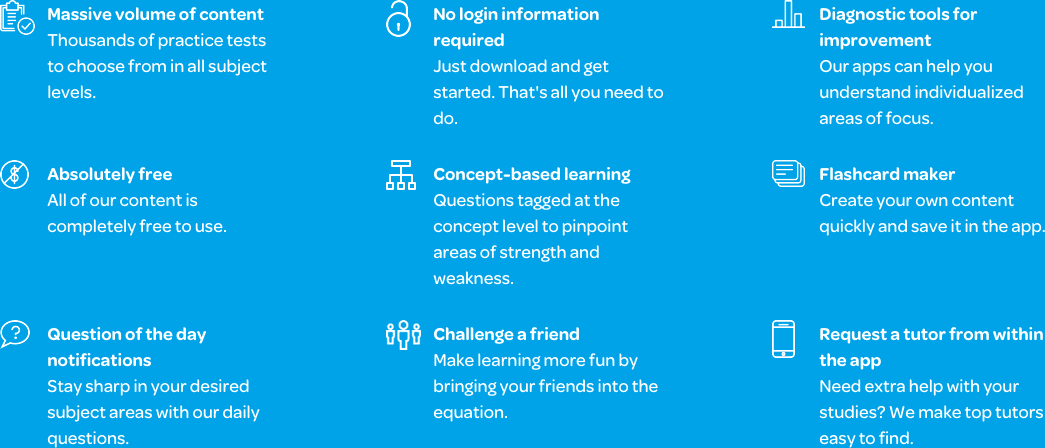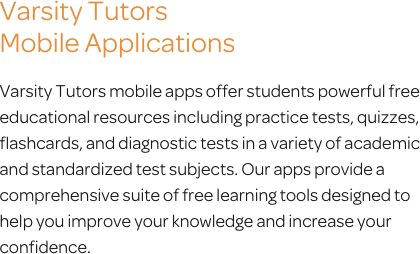The Varsity Tutors AP Physics 2 Mobile App
The AP Physics 2 course and exam include advanced topics such as thermodynamics with kinetic theory, fluid statics and dynamics, electrostatics, electrical circuits with capacitors, electromagnetism, and physical and geometric optics. Many aspects of this subject are mathematical. Students need to have a solid understanding of algebra and probability, and they should have a proficiency for working with representations and models of scientific phenomena. Your abilities will be challenged in your class, laboratory work, and study time, which is why the Varsity Tutors AP Physics 2 app, available for iOS and Android devices, is so useful.
The app allows you to access a selection of study materials, including AP Physics 2 Full-Length Practice Tests, shorter concept-specific tests, flashcards, and more, using your smartphone. On the go, you can practice using the appropriate mathematics to solve physics problems and engage in the scientific questioning needed to extend your critical thinking. The exercises will also help you come up with data collection strategies, perform data analysis, and evaluate evidence, while becoming more familiar with scientific explanations and theories. Since some of the AP Physics 2 coursework involves inquiry-based laboratories, the app provides questions that require you to understand experimental design and how to construct valid arguments to support a theory or experiment.
Section I of the AP exam is multiple choice, with 50 questions to be answered over 90 minutes, and Section II has four free- response questions you have 90 minutes to answer. The exam requires you to solve problems with math and symbols, design/describe experiments, analyze data and sources of error, and explain/reason/justify your answers. With Full-Length Practice Tests, you can test your knowledge on an array of topics to see where your strengths and weaknesses lie. The practice tests follow the exact format of the exam and include content similar to what has been included on the AP Physics 2 exam before. You can therefore use the tests to thoroughly prepare for the exam, both by studying the material and by acclimating yourself to the test format. This is important since your knowledge, skills, confidence, and endurance will all be tested during the three-hour exam.
The Full-Length Practice Tests not only assess what you know, they also provide realistic scoring, even comparing your performance to that of other test takers. Each question is timed, which also helps you track your progress as you move along. You can even share your results with friends, family, or tutors. For each question, there are detailed explanations of the concept and why the correct answer is such. This also helps you to flesh out any gaps in your understanding for topics you know more about and did answer correctly.
There are also shorter practice exercises to help you focus on individual topics. They provide the same detailed analysis the Full-Length tests do. If you want to hone in even more on specific AP Physics 2 concepts, the Learn by Concept feature of the app lets you drill down to individual sub-topics and focus on a series of problems on each, from circuits to fluid dynamics, to optics, waves, and more. The app also includes flashcards that let you work on specific problems on topics you can select from. The Question of the Day allows you get accustomed to the randomness of the exam, providing a single question each day chosen out of the vast array that are in the hundreds of practice exercises available.
You can download the Varsity Tutors AP Physics 2 app from the iTunes or Google Play Store and immediately begin studying using your iPad, iPhone, or Android device today.
66 mobile apps to choose from for your tutoring needs.

Learn More
Advanced Placement (AP) Physics 2 is the equivalent of an introductory, second-semester college-level physics course. Advanced Placement (AP) Physics 2 is the second of four physics courses offered at the AP level. It is an algebra-based physics class, and it will expand upon the concepts learned in AP Physics 1. A variety of complex topics will be explored in this course, including thermodynamics with kinetic theory, fluid statics and dynamics, PV diagrams and probability, and electrical circuits with capacitors. The course also studies physical and geometric optics, electrostatics, electromagnetism, magnetic fields, and quantum, atomic, and nuclear physics. For students who are interested in demonstrating their abilities and interest in physics to potential colleges, AP Physics 2 is a great way to do so. If this excites you, the free Varsity Tutors AP Physics 2 app is the ultimate on-the-go study companion. It’s available from iTunes and the Google Play Store.
Students who elect to enroll in AP Physics 2 should have successfully completed AP Physics 1, and should also have taken or be simultaneously enrolled in pre-calculus. The class also involves a significant amount of inquiry-based laboratory work. Twenty-five percent of the total course time is devoted to these exercises, which give students the opportunity to master best science practices. Students will engage in both individual and group experiments, which will ask students to question, observe and predict, design, analyze, and reason in hands-on scenarios.
As in AP Physics 1, students in AP Physics 2 will be expected to continue establishing and strengthening solid scientific practices. Their skills in establishing solid lines of evidence will be further refined, and students will develop skills that will aid in increasingly accurate predictions and testable explanations of natural phenomena. By the end of AP Physics 2, students will have deepened their understanding and use of mathematics, representations, and models to problem-solve. Their abilities in data collection strategies, data analysis and evaluation, and effective scientific questioning will continue to expand, and students will focus on forming even more complex connections among concepts, representations, and scales across domains. The importance of the ability to synthesize the material increases in this upper-level course, and the most successful AP Physics 2 students are those who can use evidence from a variety of sources to explain their solutions.
The syllabus of AP Physics 2 is organized around seven “Big Ideas,” which are broad ideas that help students to form a well-rounded knowledge of physics. Through a focus on broader ideas, students spend more time learning physics concepts through inquiry-based, hands-on instruction, which helps students enhance their skills in critical thinking and reasoning. Each of the seven Big Ideas of AP Physics 2 is an exploration of the scientific theories, principles, and processes of modern physics. Each of the Big Ideas are covered in-depth by the Varsity Tutors AP Physics 2 app for iPhones, iPads, and Android-powered devices.
The first six Big Ideas are identical to those explored in AP Physics 1. Students will deepen and broaden their skills and knowledge in the properties of systems and objects, such as charge and mass. They will also examine these systems’ internal structure in more detail to accurately assess the properties of the system. Students will also review the interactions that can be explained using fields existing in space. The field models used to describe distant interactions and other phenomena will increase in complexity and detail, as will newer methods of mapping points to visualize scalar fields.
AP Physics 2 continues to review and expand upon previously learned Big Ideas, such as the concepts involved in the forces used to describe an object’s interaction with other objects. Students will continue to evaluate the common characteristics of forces seen through the lens of an inertial reference frame. The interactions between systems that change the systems and interactions themselves will be applied to entire systems, and their changes will be evaluated.
Students will find that this level of AP Physics builds upon the conservation laws covered previously, and students will now be asked to perform both qualitative and quantitative treatments of velocity of a system’s central mass and conservation of momentum. The conservation of a system’s electric charge, linear momentum, and angular momentum will also be reviewed. The phenomenon of waves’ transfer of energy and momentum without permanently transferring mass will continue to be used as a model to describe other physical phenomena. The different types of waves, their effects, and unique characteristics of waves are also reviewed, and students will deepen their knowledge of interference, diffraction, standing waves, and beats.
AP Physics 2 also includes a Big Idea unique to this course. It posits that the behavior of complex systems and quantum mechanical systems can be described using the mathematics of probability. This unit examines the mathematical concepts involved in probability in detail, and students will learn to apply their analytical skills to the interpretation of a wide variety of diagrams, graphs, charts, and other representations.
The AP Physics 2 Exam is three hours long, and is a comprehensive exam that may ask students to use any of the skills or concepts they are expected to have mastered during the course. The exam will ask students to problem-solve symbolically and mathematically, design experiments and analyze data and error sources, use their understanding of complex concepts to justify their answers, and develop and interpret both conceptual and mathematical models. The exam is divided into two sections, which are weighted equally when calculating the total exam score. Section I is a 90-minute section that consists of 50 multiple-choice questions. The questions will deal with discrete items and items in sets. While many of the questions are single-select, there will also be questions where students will be asked to select two correct options. Section II is also 90 minutes in length, and it is made up of four free-response questions. One question will require fluency in experimental design, and another with qualitative and quantitative translations. There are also two short answer questions, and one will require a response of at least one paragraph. You can take full-length practice tests that mimic the actual exam when you download the free Varsity Tutors AP Physics 2 app to your iPhone, iPad, and Android device.
AP Physics 2 synthesizes the disparate topics of physics so that students can develop a thorough understanding of physics as a whole. This academically challenging course is an essential building block for students who have a strong interest in studying physics at the postsecondary level. By developing a mastery of advanced methods and applications, students build a solid foundation in physics that will support them as they move on to upper-level concepts in physics. For students who show exceptional talents in physics, enrolling in courses like AP Physics 2 is a wise choice. The benefits provided by a good performance on the exam are well worth the time and effort required to master the material. Get started today. Download the free Varsity Tutors AP Physics 2 app from iTunes and the Google Play Store.




